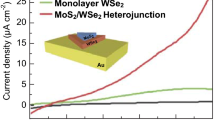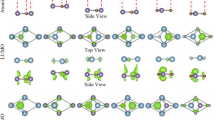Abstract
Although photocatalytic hydrogen evolution (PHE) is ideal for solar-to-fuel conversion, it remains challenging to construct a highly efficient PHE system by steering the charge flow in a precise manner. Here we tackle this challenge by assembling 1T MoS2 monolayers selectively and chemically onto (Bi12O17) end-faces of Bi12O17Cl2 monolayers to craft two-dimensional (2D) Janus (Cl2)-(Bi12O17)-(MoS2) bilayer junctions, a new 2D motif different from van der Waals heterostructure. Electrons and holes from visible light-irradiated Bi12O17Cl2 are directionally separated by the internal electric field to (Bi12O17) and (Cl2) end-faces, respectively. The separated electrons can further migrate to MoS2 via Bi–S bonds formed between (Bi12O17) and MoS2 monolayers. This atomic-level directional charge separation endows the Janus bilayers with ultralong carrier lifetime of 3,446 ns and hence a superior visible-light PHE rate of 33 mmol h−1 g−1. Our delineated Janus bilayer junctions on the basis of the oriented assembly of monolayers presents a new design concept to effectively steer the charge flow for PHE.
Similar content being viewed by others
Introduction
Photocatalytic hydrogen evolution (PHE) from water via solar energy and semiconductor photocatalysts provides the prospect of replacing fossil fuels with carbon-free and sustainable hydrogen energy1. Yet so far, its realization is still a mirage because PHE efficiency is thwarted to a large extent by the undesirable electron–hole recombination arisen from the random charge flow after the electron–hole separationFig. 1b–e) coupling with X-ray photoelectron spectroscopy (XPS) (Fig. 1f) and X-ray diffraction pattern (Supplementary Fig. 5 and Supplementary Note 5) identified the small and large nanosheets as MoS2 and Bi12O17Cl2, respectively. S K-edge X-ray absorption near-edge structure spectra (XANES) (Fig. 1g) revealed that the MoS2 monolayers in the bilayer showed a distorted 1T metallic phase15. 3D topographic atomic force microscopy (AFM) images (Fig. 1h,i) and their corresponding height profiles (Fig. 1j,k) demonstrated that the average thickness values of the small-sized and large-sized nanosheets were 0.686 and 0.717 nm, respectively, well-matching with the theoretical ones of the MoS2 and Bi12O17Cl2 monolayers (Fig. 1l, Supplementary Figs 2–4 and Supplementary Note 2–4), which further evidenced the assembly of MoS2 on Bi12O17Cl2. More interestingly, we found that all the MoS2 sheets were anchored on the same surface in Bi12O17Cl2, which was further evidenced by their side-view TEM image (Fig. 1m). These observations clearly demonstrate the occurrence of an oriented assembly. As 1L-BOC has an asymmetric structure consisting of (Cl2) and oxygen-deficient (Bi12O17) end-faces and their assembly might be initiated by OVs of (Bi12O17) end-faces, we could thus deduce that 1L-MS were anchored selectively on the (Bi12O17) end-faces of 1L-BOC. The aberration-corrected high-angular annular dark field scanning TEM (HAADF-STEM) image (Fig. 1n) and energy loss spectroscopy (EELS) elemental maps (Fig. 1o–s) of their cross-sectional atomic structures provided direct, atomic-resolution evidences that this oriented assembly resulted in 2D Janus bilayer junctions of (Cl2)-(Bi12O17)-(MoS2). Meanwhile, we also found that the amount of MoS2 loaded on Bi12O17Cl2 decreased with OVs quenching, and the assembly behaviour annihilated when OVs were completely removed (Supplementary Figs 5–7, Supplementary Table 1 and Supplementary Note 6 and 7), confirming that the oriented assembly of 2D Janus (Cl2)-(Bi12O17)-(MoS2) bilayer junctions was driven by the OVs on the (Bi12O17) end-faces of 1L-BOC.
(a) Top-view TEM image, (b–e) elemental map** images, (f) XPS spectra, (h,i) AFM images, side-view TEM image (m) and atomic-resolution HAADF-STEM image (n), and (o–s) the corresponding EELS elemental maps of BOC-MS. Scale bar, 500 nm, 1 μm, 500 nm, 10 nm and 5 Å, in a,h,i,m,n, respectively. (g) S K-edge XANES spectra of BOC-MS, 1L-MS and bulk MS. (j) Height profiles along the lines in i. (k) Comparison of the average thicknesses of 1L-BOC and 1L-MS in BOC-MS. The error bars in k represent the s.d. of over 100 independent AFM measurements. (l) The theoretical thicknesses of MoS2 and Bi12O17Cl2 monolayers.
Visible light PHE
The successful design of BOC-MS featuring Janus (Cl2)-(Bi12O17)-(MoS2) bilayer junctions allowed us to first explore their PHE activity under visible light (λ>420 nm). Visible light irradiation of the solution containing BOC-MS and ascorbic acid (organic scavengers) gave a typical gas chromatograph (GC) signal of H2 at the retention time of 82 s (Fig. 2a), consistent with the previously reported results16. At the optimal MoS2 loading (10 wt%, Supplementary Fig. 8a) and ascorbic acid concentration (0.3 mol l−1, Supplementary Fig. 8b), BOC-MS delivered a PHE rate of 33 mmol h−1 g−1 (Fig. 2b) and a quantum yield of around 36% at 420 nm (Fig. 2h), representing the currently achieved state-of-the-art PHE activity among all the MoS2-based, monolayer-based and bismuth oxyhalide-based PHE systems (Supplementary Tables 2–4). This activity could last over 100 h without significant decay and the bilayer structures were very stable (Supplementary Fig. 9 and Supplementary Note 8), indicating BOC-MS were highly active and robust for visible-light PHE. The absence of OVs signal in BOC-MS ruled out the possibility that its superior PHE activity was arisen from the OVs (Fig. 2c). During PHE, dehydroascorbic acid and its hydrated compound as the oxidized products of ascorbic acid were detected (Fig. 2d)17, indicating that ascorbic acid acted as an efficient hole scavenger to suppress the electron and hole recombination. Even using ascorbic acid as the hole scavenger and having surface OVs, 1L-BOC only exhibited a PHE rate of 0.86 mmol h−1 g−1, 1/38 that of BOC-MS.
(a) A typical GC signal of H2 formed from BOC-MS involved PHE system. (b) Cycling tests of PHE over BOC-MS and 1L-BOC. Reaction conditions: 10 mg catalysts; 0.3 mol l−1 ascorbic acid; visible light (λ>420 nm). The reaction cell was evacuated each 10 h without renewing ascorbic acid solution. (c) EPR spectra of 1L-BOC and BOC-MS. (d) 13C NMR spectra of the solutions containing BOC-MS and ascorbic acid after 0, 45 and 90 h of PHE experiments. (e) DOS and (f) Mott–Schottky plots of 1L-BOC and 1L-MS. (g) Surface photovoltage spectroscopy of 1L-BOC, 1L-MS and BOC-MS. (h) Ultraviolet–visible diffuse reflectance spectrum of BOC-MS, 1L-BOC and 1L-MS, and PHE quantum yields of BOC-MS plotted as a function of wavelength of the incident light. (i) Band alignments in 1L-BOC and 1L-MS.
This giant PHE activity enhancement by the introduction of 1L-MS ignited our interest in unravelling how 1L-MS assisted 1L-BOC to precisely steer charge flow across the assembled Janus bilayer junctions. Density functional theory calculations of 1L-MS showed its density of states resided across the Fermi level (Fig. 2e), revealing its metallic characteristic25,26. It was found that I1 increased ca. 17-fold from 5.23% for BOC-MS-Mix to 86.59% for BOC-MS, and its magnitude highly depended on the amounts of Bi–S bonds, confirming the electron transport from 1L-BOC to 1L-MS via the Bi–S bonds within BOC-MS (Fig. 3v). This interfacial electron transfer was ultrafast with a rate of up to 5.8 × 10−11 s−1, as calculated by (τBOC-MS)−1−(τBOC-MS-Mix)−1, where τBOC-MS and τBOC-MS-Mix are the average TA lifetimes for BOC-MS and BOC-MS-Mix, respectively. As a result, the electron flow from 1L-BOC to 1L-MS required only 0.68 ps (τ1 for BOC-MS), which was inferior to the time scale (3–20 ps) required for the surface charge recombination1,Full size image










